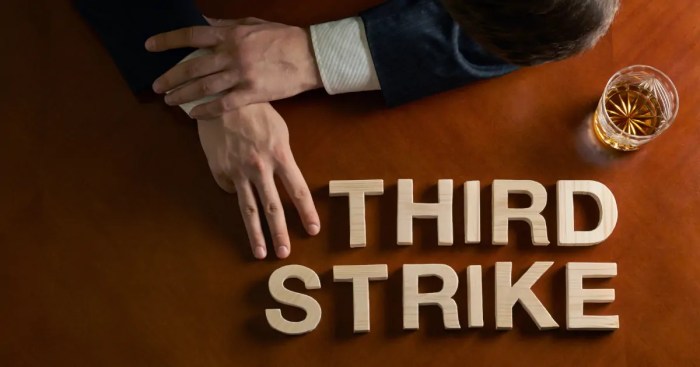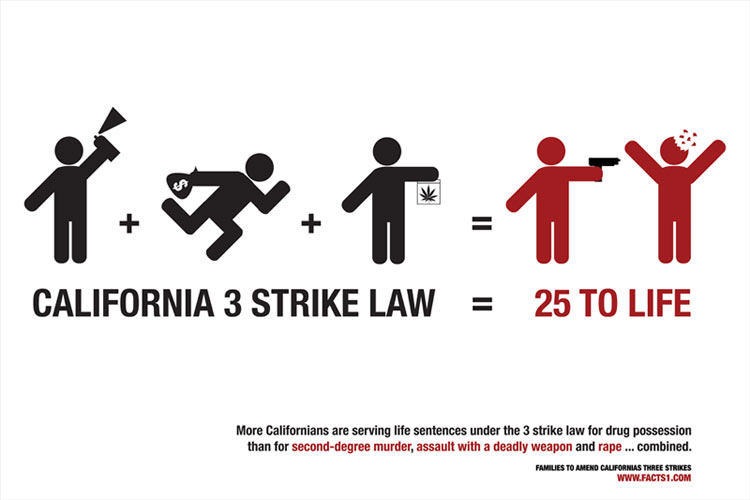
Is the three-strikes law an ethical policy? This question has sparked debate for decades, with strong arguments on both sides. The law, designed to deter repeat offenders and protect communities, has been hailed as a vital tool for public safety. However, critics argue that it disproportionately impacts marginalized groups, inflates prison populations, and fails to address the root causes of crime. This exploration delves into the history, arguments, and potential consequences of the three-strikes law, examining its impact on the criminal justice system and society at large.
The three-strikes law, first implemented in California in 1994, mandates lengthy prison sentences for individuals convicted of three or more serious felonies. The law’s proponents believe it effectively deters crime by imposing severe consequences for repeat offenders. They argue that it protects communities from dangerous criminals and ensures justice for victims. Conversely, opponents highlight the law’s potential to lead to excessive incarceration, particularly for non-violent offenses. They also point to its disproportionate impact on minorities and its high cost to taxpayers. The debate surrounding the three-strikes law raises fundamental questions about the balance between public safety, individual rights, and the effectiveness of punishment in addressing crime.
The Three-Strikes Law

The Three-Strikes Law, a controversial criminal justice policy, has been implemented in various forms across the United States. Its primary goal is to deter crime by imposing lengthy prison sentences on repeat offenders. The law has been subject to intense debate, with proponents arguing for its effectiveness in reducing crime rates and opponents criticizing its harshness and potential for disproportionate impact on certain demographics.
Origins and Rationale
The Three-Strikes Law originated in California in 1994, following a public outcry over high-profile violent crimes. The law was seen as a response to public fear and a desire for tougher sentencing for repeat offenders. The rationale behind the law was based on the belief that a small number of repeat offenders were responsible for a disproportionate share of crime, and that by incapacitating these individuals, society could significantly reduce crime rates.
Key Provisions
The Three-Strikes Law typically involves a tiered sentencing structure, with progressively longer prison terms imposed for each subsequent offense. The specific provisions of the law vary by state, but generally include the following:
- A “strike” is typically defined as a felony conviction, although some states may include certain misdemeanors.
- A third strike, usually a serious felony, triggers a mandatory life sentence, often without the possibility of parole.
- The law often includes “three-strikes” provisions for offenses that may not be considered serious felonies, such as drug possession or theft.
- Sentencing guidelines may vary depending on the severity of the offenses and the offender’s criminal history.
Examples of Implementation
One of the most well-known cases involving the Three-Strikes Law is the case of Gary Ewing, a man who was sentenced to 25 years to life in prison for stealing three golf clubs. Ewing had two prior convictions for burglary, which triggered the three-strikes provision. This case sparked debate about the law’s potential for disproportionate sentencing and the fairness of its application. Another notable case is the case of Leonard Diaz, who was sentenced to 25 years to life for stealing a video cassette. Diaz had two prior convictions for robbery, which qualified him for the three-strikes provision. These cases highlight the controversial nature of the Three-Strikes Law and its potential for imposing severe punishments for relatively minor offenses.
Arguments for the Three-Strikes Law

The Three-Strikes Law, a legislative measure aimed at imposing severe penalties on repeat offenders, has been a subject of intense debate for decades. While opponents argue that it is overly harsh and disproportionate, proponents maintain that it is a necessary tool for deterring crime and protecting communities. This section will explore the arguments in favor of the Three-Strikes Law, examining its effectiveness in deterring crime, its contribution to public safety, and the rationale behind imposing harsh sentences on repeat offenders.
Deterrence of Crime
The primary argument in favor of the Three-Strikes Law is its purported effectiveness in deterring crime. Proponents argue that the law’s harsh penalties create a strong deterrent effect, discouraging individuals from committing crimes, especially repeat offenders. They believe that the fear of lengthy prison sentences acts as a powerful disincentive, leading individuals to reconsider their actions and choose lawful alternatives. This deterrence effect, they argue, ultimately leads to a reduction in crime rates.
Public Safety and Community Protection
Another key argument in favor of the Three-Strikes Law is its contribution to public safety and community protection. Proponents argue that by removing repeat offenders from society, the law protects communities from further victimization. They believe that individuals who have repeatedly committed serious crimes pose a significant threat to public safety and that incapacitating them through lengthy prison sentences is essential for safeguarding communities. This argument emphasizes the law’s focus on protecting innocent citizens and preventing further harm.
Rationale for Harsh Sentences
The Three-Strikes Law advocates for imposing harsh sentences on repeat offenders, often resulting in life imprisonment for individuals who have committed three felonies. Proponents argue that this approach is justified by the nature of repeat offenses. They believe that individuals who repeatedly commit serious crimes demonstrate a pattern of criminal behavior and a disregard for the law. They argue that these individuals are a danger to society and that lengthy prison sentences are necessary to protect the public and ensure justice. This argument emphasizes the need for accountability and punishment for repeat offenders who have shown a persistent pattern of criminal activity.
Arguments Against the Three-Strikes Law
The Three-Strikes Law, while intended to enhance public safety, has faced significant criticism for its potential negative consequences. Critics argue that the law’s rigid application can disproportionately impact marginalized communities, impose excessive financial burdens on taxpayers, and prioritize punishment over rehabilitation.
Disproportionate Impact on Marginalized Communities
The Three-Strikes Law’s potential to disproportionately affect marginalized communities is a major concern. This is because individuals from disadvantaged backgrounds often face systemic barriers that increase their risk of encountering the criminal justice system. For instance, poverty can lead to increased crime rates, and racial bias in policing can result in higher arrest rates for minorities. The law’s harsh sentencing guidelines can trap individuals in a cycle of incarceration, exacerbating existing inequalities.
Financial Burden of Long-Term Incarceration, Is the three-strikes law an ethical
The high cost of long-term incarceration associated with the Three-Strikes Law poses a significant financial burden on taxpayers. The law’s focus on lengthy sentences results in overcrowded prisons and increased expenditures on housing, healthcare, and security. This financial strain can divert resources from other crucial public services, such as education and healthcare.
Ethical Concerns Regarding Focus on Punishment
The Three-Strikes Law’s emphasis on punishment over rehabilitation raises ethical concerns. By prioritizing lengthy sentences, the law may hinder opportunities for offenders to address the underlying causes of their criminal behavior. This can lead to recidivism, as individuals released after long periods of incarceration may lack the necessary support and resources to reintegrate into society successfully.
Alternatives to the Three-Strikes Law

The Three-Strikes Law, while aiming to deter crime, has faced criticism for its harsh sentencing and its impact on prison populations. As such, several alternative strategies have been proposed to address repeat offenses, prioritizing rehabilitation and reintegration into society.
Sentencing Strategies Emphasizing Rehabilitation
Alternative sentencing strategies can prioritize rehabilitation and reintegration by focusing on addressing the underlying causes of criminal behavior and providing individuals with the tools and support they need to make positive changes. These strategies include:
- Drug Treatment Courts: These courts provide specialized treatment and supervision for individuals with substance abuse issues. They aim to address addiction, reduce recidivism rates, and improve the lives of offenders.
- Mental Health Courts: These courts offer specialized services for individuals with mental health conditions. They provide access to treatment, counseling, and support services to help offenders manage their conditions and reduce the likelihood of future offenses.
- Restorative Justice Programs: These programs focus on repairing the harm caused by crime and involve the offender, the victim, and the community in the process of healing and reconciliation. They aim to promote accountability, empathy, and forgiveness, ultimately reducing the likelihood of re-offending.
- Community Corrections: These programs involve supervising offenders in the community, providing them with access to support services, and helping them to reintegrate into society. They aim to reduce the likelihood of re-offending by addressing the factors that contribute to criminal behavior.
Comparison of Approaches to Repeat Offenses
Different approaches to addressing repeat offenses vary in their focus and methods.
- Deterrence-based approaches, like the Three-Strikes Law, aim to deter crime by imposing harsh punishments. They rely on the principle that severe consequences will discourage individuals from engaging in criminal behavior.
- Rehabilitation-based approaches focus on addressing the underlying causes of criminal behavior, such as substance abuse, mental health issues, or lack of education and employment opportunities. They aim to provide offenders with the support and resources they need to make positive changes and reduce their likelihood of re-offending.
- Restorative justice approaches prioritize repairing the harm caused by crime and involve the offender, the victim, and the community in the process of healing and reconciliation. They aim to promote accountability, empathy, and forgiveness, ultimately reducing the likelihood of re-offending.
Benefits and Drawbacks of Alternative Strategies
Alternative sentencing strategies offer potential benefits but also come with drawbacks:
- Benefits:
- Reduced recidivism rates: By addressing the underlying causes of criminal behavior and providing offenders with the support they need to make positive changes, rehabilitation-based approaches can effectively reduce recidivism rates.
- Cost-effectiveness: Investing in rehabilitation programs can be more cost-effective than incarcerating individuals for long periods, as it reduces the likelihood of future offenses and the associated costs of imprisonment.
- Improved public safety: By reducing recidivism rates, alternative strategies can contribute to improved public safety by preventing individuals from re-offending.
- Enhanced community well-being: By providing offenders with the support they need to reintegrate into society, alternative strategies can promote community well-being by reducing crime rates and fostering a more just and equitable society.
- Drawbacks:
- Potential for leniency: Some critics argue that alternative strategies may be too lenient on offenders and may not adequately deter criminal behavior.
- Resource constraints: Implementing effective rehabilitation programs requires significant resources, including funding for staffing, treatment, and support services.
- Public perception: Some members of the public may be hesitant to support alternative sentencing strategies, particularly if they perceive them as being too lenient or as not providing adequate protection for victims.
Impact of the Three-Strikes Law on the Criminal Justice System: Is The Three-strikes Law An Ethical
The Three-Strikes Law has had a significant impact on the criminal justice system, leading to both intended and unintended consequences. Its effects are felt in various areas, from prison populations and overcrowding to public perceptions of crime and punishment.
Impact on Prison Populations and Overcrowding
The Three-Strikes Law has contributed significantly to prison overcrowding in many states. The law’s mandatory sentencing guidelines, which often impose lengthy prison terms for repeat offenders, have resulted in a substantial increase in the number of inmates. This has put a strain on prison resources, leading to challenges in providing adequate housing, healthcare, and rehabilitation programs. For example, California, which implemented a version of the Three-Strikes Law in 1994, experienced a dramatic increase in its prison population, exceeding its capacity by over 200%. This overcrowding has led to concerns about the quality of life for inmates and the potential for violence within prison walls.
Conclusive Thoughts
The three-strikes law remains a complex and controversial issue, prompting ongoing discussion about its effectiveness, ethical implications, and impact on the criminal justice system. While it aims to enhance public safety, its potential to disproportionately impact marginalized communities, inflate prison populations, and discourage rehabilitation raises concerns. Ultimately, the debate surrounding the three-strikes law necessitates a nuanced approach that considers the various perspectives and explores alternative solutions to address repeat offenses. This approach should prioritize both public safety and the principles of fairness and rehabilitation within the criminal justice system.
FAQ Summary
What are some examples of crimes that qualify for the three-strikes law?
Crimes that typically qualify include violent offenses like murder, rape, and robbery, as well as drug trafficking and certain property crimes.
How does the three-strikes law affect prison overcrowding?
The law has significantly contributed to prison overcrowding in many states, leading to strained resources and challenges in providing adequate rehabilitation programs.
Are there any alternatives to the three-strikes law?
Yes, alternatives include sentencing guidelines that focus on rehabilitation, drug treatment programs, and community-based interventions.



